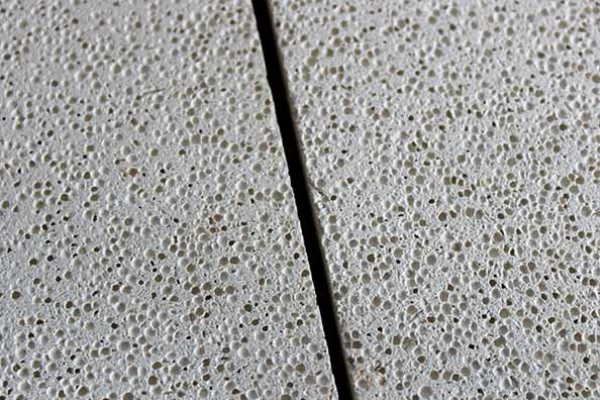
Korund - mulit jednocześnie z korundem i mulitem to dwa doskonałe występy.
Porowata ceramika to rodzaj ceramicznego materiału, który składa się z wielu porów ułożonych w przestrzeni na różne sposoby.
Porous ceramics according to the pore size can be divided into coarse aperture porous ceramics (pore diameter > 500μm) large aperture porous (500μm > pore diameter > 100μm), porous ceramics in the aperture (100μm > pore diameter > 10μm), porous ceramics in the small aperture (10μm > pore diameter > 1μm), porous ceramics (pore diameter < 1μm).
The structure of the pores in the ceramics can be divided into open pore type porous ceramics, closed pore ceramics, and penetrating porous ceramics. Porous ceramics have uniformly distributed pores or many penetrating pores, with high permeability. There are many pores in the matrix so it has a small bulk density.
Porous ceramics developed with specific surfaces can produce unique physical surface properties and can be formed on the liquid and gas media selective permeability, while further reducing the thermal conductivity of ceramics.
W tym samym czasie, ceramic materials have unique high-temperature resistance, odporność na korozję, high chemical stability, and dimensional stability, porous ceramics as a new type of material developed rapidly.
Obecnie, porous ceramics are used in gas sensors, catalyst carriers, filters for hot gases or molten metals, and high-temperature refractory insulation materials. As catalyst carriers, porous ceramics have the advantages of high-temperature resistance, odporność na korozję, no contamination of catalyst, and low cost compared with other catalyst carriers.
Lightweight mullite refractory bricks to mullite main crystalline phase of high alumina refractory materials, general alumina content between 65% -75%. Mullite lightweight refractory bricks’ refractory temperature can reach more than 1790 ℃. Load softening starting temperature of 1600-1700 ℃. Dobra odporność na szok termiczny.
Lightweight porous mullite bricks have a small density, large specific surface area, low thermal conductivity and coefficient of thermal expansion, high melting point, i dobry odporność na korozję, and have a very broad application prospect in the field of high-temperature thermal insulation, filtration, catalytic and so on.
Mullite bricks made of mullite as the main raw material, with high-temperature strength, low creep rate, niska rozszerzalność cieplna, strong chemical erosion resistance, i dobrą odporność na szok termiczny, itp., can be used for hot air furnace vault and combustion chamber in the middle and upper, but also for ceramic burner bricks.
Obecnie, Cegły ogniotrwałe z mulitu o wysokiej czystości są stosowane w różnych wyłożeniach pieców wysokotemperaturowych, w tym piece piecowe, wielkie piece, koryta do wylewania gorącego żelaza, oraz materiały do wyłożenia pieca do ciągłego odlewania.
Cynowe cegły kąpielowe na bazie mulitu są kluczowym materiałem ogniotrwałym do pieców ze szkłem pływającym na etapie formowania.
Corundum – mullite at the same time with corundum and mullite two excellent performances. Jest to wysokiej jakości materiał ogniotrwały, odporny na wysokie temperatury, wysoka wytrzymałość mechaniczna, odporność na szorowanie, erozja, dobra odporność na szok termiczny, i niewielki efekt pęcherzy, który jest szeroko stosowany w piecach wysokotemperaturowych.
Mulit-kordieryt jest spiekany z mulitem jako kordierytem kruszywowym jako materiałem podstawowym. Współczynnik rozszerzalności cieplnej materiału bazowego kordierytu jest mniejszy niż kruszywa mulitowego. Z powodu niedopasowania ich współczynników rozszerzalności, tworzą się mikropęknięcia, poprawiono wytrzymałość materiału mulitowo-kordierytowego, oraz poprawiono stabilność termiczną mebli do pieca mulitowo-kordierytowego.
Materiały mulitowo-kordierytowe charakteryzują się doskonałą odpornością na szok termiczny i dobrą odpornością na wysokie temperatury i są powszechnie stosowane w meblach do pieców ceramicznych przez producentów krajowych i zagranicznych.
Materiały ogniotrwałe PER wiele lat doświadczenia ci to mówi. Dzięki swojej lekkości i doskonałym właściwościom termoizolacyjnym, Lekkie cegły ogniotrwałe z mulitu są szeroko stosowane w wyłożeniach ogniotrwałych na gorącą powierzchnię lub w warstwie izolacji termicznej wielu rodzajów urządzeń cieplnych, co stwarza warunki do poprawy wykorzystania energii urządzeń. Mullite lightweight refractory bricks can be used as hot surface refractory lining or other refractory backing insulation layer, used in petroleum, przemysł chemiczny, ethylene cracking furnace, tube heating furnace, ammonia converters, gas furnaces, high-temperature shuttle kilns, piece tunelowe, ceramic roller kiln, push plate kiln and other industrial furnaces furnace heat insulation materials and so on.
The use of different temperatures is mainly divided into 1350 lekkie cegły mulitowe, 1450 mulitowe cegły izolacyjne, 1550 mullite lightweight bricks, i tak dalej.
Od października, ceny tlenku glinu nadal rosły, and China's largest bauxite importer - a…
Pierwszy, Cegła o wysokiej zawartości tlenku glinu: The Leader In High Temperature Refractories As a leader in high-temperature…
The application of refractory bricks in the kiln immediately endangers the operation rate of the…
Analysis Of The Causes Of Common Quality Problems In Tunnel Kiln Construction And Measures To…
Corundum quality refractory castables are made from corundum to the new jade refractory insulation material…
Analiza surowców aluminiowo-krzemowych prof. Li Yong of the University of Science and…